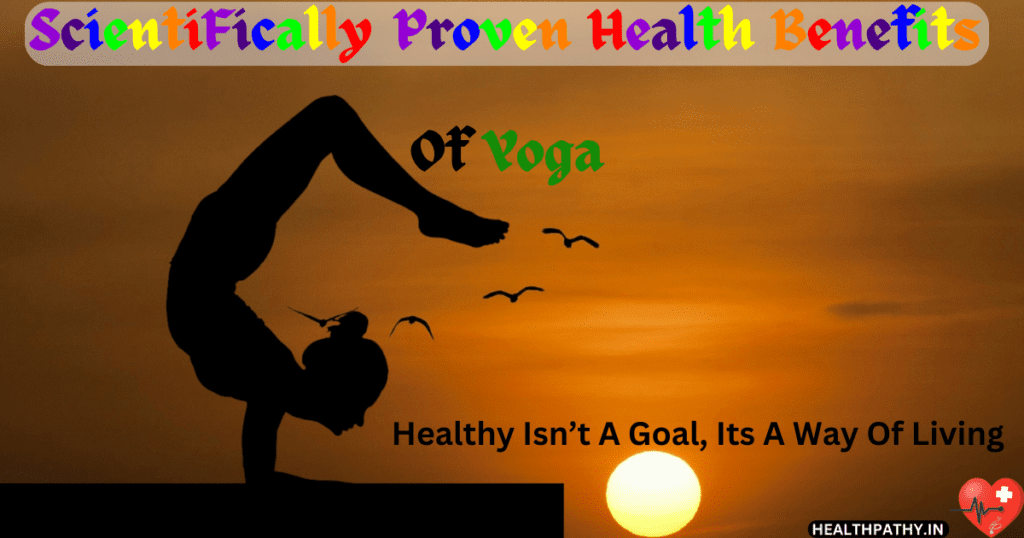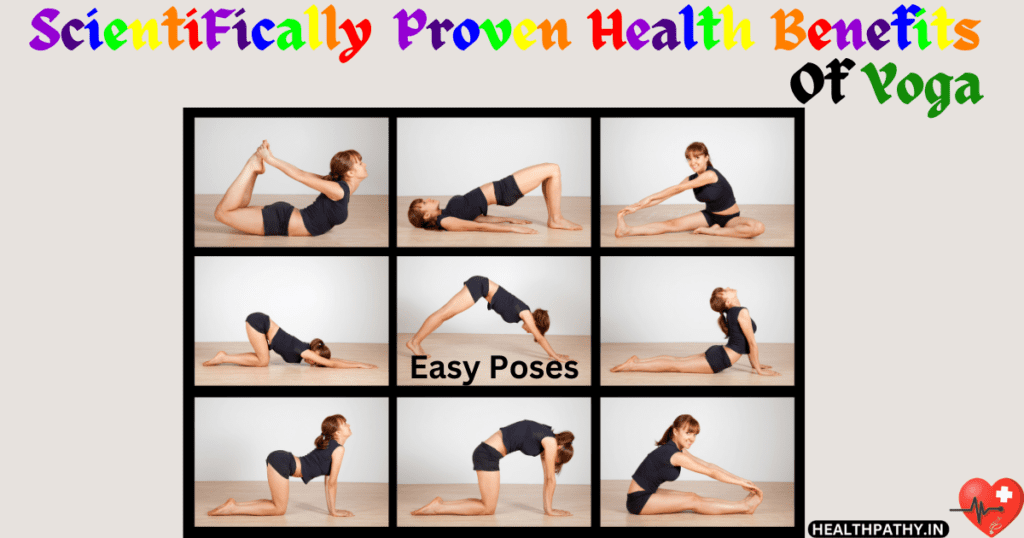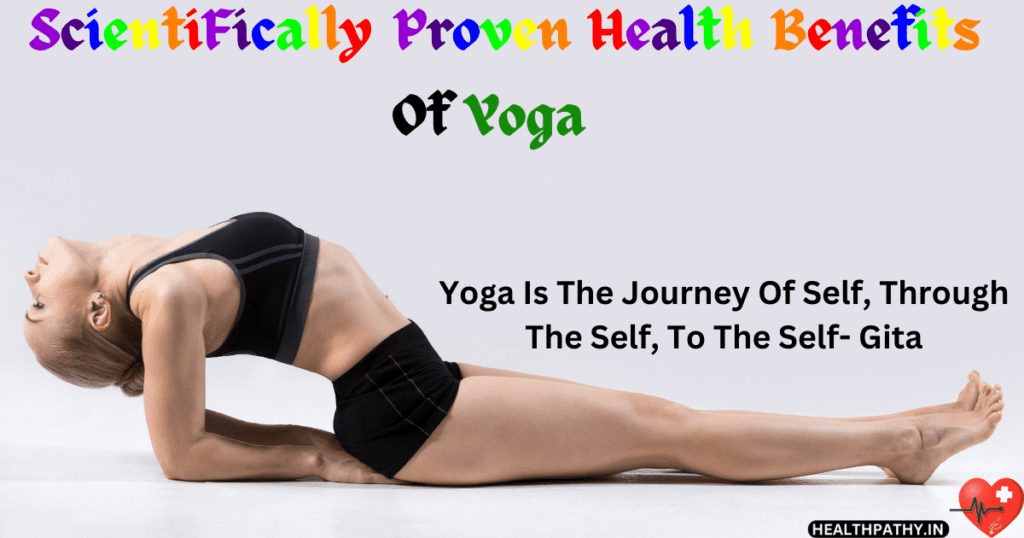Hello, I’m a homeopathic doctor with almost two decades of clinical experience, having started my work in 1997. My passion is to simplify tough medical concepts so that everyone can understand them. Join me on this educational adventure as I analyze the Scientifically Proven Health Benefits of Yoga in a way that is relatable and accessible to everyone. Let’s embark on a trip into the world of holistic health together!


Unveiling the Healing Powers of Yoga: A Path to Holistic Health
In a state-of-the-art, fast-paced international environment, the pursuit of true fitness is frequently overshadowed by means of the needs of everyday life. As we grapple with stress, pressure, an imbalanced life, and various health worries, it’s important to explore holistic procedures for well-being in article Scientifically Proven Health Benefits Of Yoga. Yoga, a practice that originated in ancient India, has emerged as a powerful device for reinforcing physical, mental, and emotional fitness. Let’s delve into the myriad advantages it gives for our ordinary well-being.
The Physical Realm: A Strong and Flexible Body
- Enhanced Flexibility: Regular yoga exercise promotes flexibility by stretching and lengthening muscle tissue. Improved flexibility reduces the risk of harm and enhances the range of movement in joints.
- Strength and Muscle Tone: Yoga asanas (postures) are a good exercise that requires holding various positions, which construct muscle energy and increase muscle tone.
- Better Posture: The emphasis on frame cognizance and alignment in yoga enables you to improve posture, reducing the risk of lower back, neck, and muscle troubles.
- Balance and Stability: Many yoga poses project balance and stability, which are vital for coordination and preventing falls, mainly as we age.
The Mental Landscape: A Tranquil Mind
- Stress Reduction: Yoga contains deep breathing, meditation, and mindfulness, reducing the body’s stress response. It calms thoughts and allows one to handle pressure.
- Improved Concentration: The meditative components of yoga enhance recognition and awareness, making it easier to deal with day-by-day obligations and challenges.
- Emotional Balance: Yoga promotes emotional stability, decreasing symptoms of tension and despair. It encourages superb thinking and emotional resilience.
- Better Sleep: A normal yoga exercise can cause progressive sleep patterns, ensuring a restful and rejuvenating night’s sleep.
The Inner Self: Emotional and Spiritual Growth
- Self-Acceptance: Yoga encourages self-attractiveness and self-love, fostering a tremendous self-image and elevated self-esteem.
- Mind-Body Connection: Yoga deepens the connection between the thoughts and body, allowing for a more profound knowledge of oneself.
- Spiritual Awareness: For many, yoga is a spiritual practice that connects them to a better experience of purpose or spirituality, leading to an extra-gratifying life.
A Holistic Approach to Health
Yoga offers a holistic technique for fitness, addressing bodily, mental, and spiritual well-being. Whether you are a beginner or a pro-yogi, the advantages are accessible to all. It’s a versatile exercise that may be tailored to character desires and dreams, making it a valuable addition to everybody’s adventure and bringing them closer to a more healthy, extra-balanced life.
In conclusion, the historic practice of Scientifically Proven Health Benefits Of Yoga is a profound device for achieving holistic health. By embracing its bodily, mental, and spiritual dimensions, we will enjoy the transformative power of yoga, lead more healthy, extra-pleasant lives, and follow a healthy diet plan. So, roll out your mat, take a deep breath, and embark on a route to well-being through the timeless expertise and wisdom of yoga.


Simple Yoga Pose-Asanas
Certainly, there are many simple yoga positions, frequently referred to as “Asanas,” that might be appropriate for beginners and offer superb blessings. Here are some simple yoga poses to get you started on your Scientifically Proven Health Benefits Of Yoga’s adventure:
1. Mountain Pose (Tadasana): Stand along with your feet collectively, hands forward on the mat. Align your body, hold your spine straight, and loosen up your shoulders. Take deep breaths and be cognizant of grounding yourself.
2. Child’s Pose (Balasana): Begin with your arms and knees (tabletop function). Sit back on your heels, extending your arms ahead on the mat. Rest your forehead on the ground and relax in this mild, resting pose.
3. Downward-Facing Dog (Adho Mukha Svanasana): Start with a tabletop function. Lift your hips toward the ceiling, straightening your legs. Spread your fingers and press your palms into the mat. Let your head cling freely, creating an inverted “V” shape with your body.
4. Cat-Cow Pose (Marjaryasana-Bitilasana): Begin in a tabletop role. Inhale and arch your back, lifting your head and tailbone (Cow Pose). Exhale and round your back, tucking your chin (Cat Pose). Repeat these actions in a flowing, rhythmic motion.
5. Bridge Pose (Setu Bandha Sarvangasana): Lie on your lower back together with your knees bent and feet flat on the floor. Place your fingers by way of your aspects, palms going through down. Inhale, raise your hips, and decrease. Go in reverse on the floor. Keep your toes and shoulders on the ground. Hold for some breaths.
6. Cobra Pose (Bhujangasana): Lie face down together with your palms beside your chest. Inhale and lift your upper body off the ground, using your back muscle tissue. Keep your pelvis and lower body on the mat.
7. Warrior I (Virabhadrasana I): Stand with one foot forward and the alternative foot ack. Turn your back foot out barely and bend your front knee. Raise your arms overhead and preserve the pose, looking ahead.
8. Warrior II (Virabhadrasana II): Similar to Warrior I, however, your hips and shoulders are open to the side. Extend your arms parallel to the ground, along with your gaze over the front hand.
9. Tree Pose (Vrikshasana): Stand on one leg and place the sole of the alternative foot in your inner thigh. Balance on one leg and preserve your hands in a prayer role at your chest.
10. Easy Pose (Sukhasana): Sit cross-legged on the ground or on a cushion. Keep your back straight and your arms at your knees. This is a comfy seated pose for meditation and breathing exercises.
11. Seated Forward Bend (Paschimottanasana): Sit with your legs straight in front of you. Inhale, then exhale even as you bend at the hips to reach your toes. Hold onto your feet, ankles, or legs.
These poses are not the most effective, but they additionally offer a number of physical and intellectual benefits. They help enhance posture and flexibility and reduce stress. Remember to breathe deeply and concentrate on your body. Yoga must be a comfy and exciting practice, so do not push yourself too hard, particularly as a beginner. As you become more acquainted with those poses, you may discover greater, superior ones if you want.


Yoga Helps In Disease:
Certainly, here are some yoga positions that may assist in alleviating commonplace fitness issues:
1. Stress and Anxiety: Child’s Pose (Balasana): Kneel on the ground, sit back in your heels, and extend your palms ahead along with your forehead resting on the ground. This pose is soothing and relieves strain.
2. Back Pain: Cat-Cow Stretch: Begin with your palms and knees. Inhale your lower back (cow) and exhale around your lower back (cat). This gentle movement can ease tension inside the backbone.
3. Digestive Issues: Seated Twist (Ardha Matsyendrasana): Sit with your legs extended, bend one knee, and place the foot outside the alternative knee. Twist your upper body toward the bent knee. This pose can help with digestion.
4. Insomnia: Legs Up the Wall (Viparita Karani): Lie to your back along with your legs up a wall. This pose can assist in loosening up the body and helping with sleep.
5. Headaches: Bridge Pose (Setu Bandhasana): Lie on your back, bend your knees, and raise your hips off the floor. This can relieve tension and headaches.
6. High Blood Pressure: Corpse Pose (Savasana): Lie on your back with arms and legs extended, which specialize in deep, slow breaths. These resting poses can assist in decreasing blood pressure.
7. Menstrual Pain: Reclining Bound Angle Pose (Supta Baddha Konasana): Lie on your back, bend your knees, and bring the soles of your feet together. This can ease menstrual pain.
8. Arthritis: Chair Pose (Utkatasana): Stand with your feet hip-width aside and bend your knees as if sitting in a chair. This low-effect pose can assist with joint flexibility.
9. Respiratory Issues: Alternate Nostril Breathing (Nadi Shodhana): Sit quite simply and use your thumb and ring finger to alternately close your nostrils while respiring. This technique can improve lung function and alleviate respiratory problems.
10. Weight Management: Warrior II (Virabhadrasana II): Stand together with your legs extended apart, extend your arms, and bend one knee. This pose can help fortify and tone muscular tissues, assisting in weight control.
11. Lower Back Pain: Child’s Pose (Balasana): This pose, as mentioned earlier, is likewise beneficial for lower back pain remedies.
12. Respiratory Issues (Asthma): Cobra Pose (Bhujangasana): Lie on your stomach, place your palms underneath your shoulders, and gently arch your upper body. It can assist in improving lung capacity and alleviate respiratory problems.
13. Digestive Issues: Bow Pose (Dhanurasana): Lie on your stomach, bend your knees, and reach back to hold your ankles. This pose can stimulate the digestive organs.
14. Migraines: Downward-Facing Dog (Adho Mukha Svanasana): Start on your hands and knees, then raise your hips into an inverted V shape. This pose can relieve tension that can trigger migraines.
15. Osteoporosis: Tree Pose (Vrikshasana): Stand on one leg and place the sole of the opposite foot on your inner thigh. This balance pose can help enhance bone density.
16. High Blood Pressure: Seated Forward Bend (Paschimottanasana): Sit with your legs extended, then reach in your feet. This pose can assist in lessening strain and decreasing blood pressure.
17. Menstrual Pain: Camel Pose (Ustrasana): Kneel, then lean again to understand your heels. This pose can alleviate menstrual soreness.
18. Insomnia: Corpse Pose (Savasana): This relaxation pose, as noted earlier, is likewise beneficial for promoting better sleep.
Remember, yoga is a complementary approach to those situations and should not replace medical treatment when necessary. Always seek advice from a healthcare expert when you have a scientific condition.
These yoga poses, while practiced often and successfully, can contribute to better universal fitness and well-being. However, if you have specific fitness issues, seek advice from a healthcare professional or a licensed yoga teacher before starting a yoga exercise.
Must Read:
Scientifically Proven Health Benefits Of Family
Scientifically Proven Health Benefits Of Social Networks
Must Watch:
Homeopathy Definition_The Hahnemann Legacy
Friday 04 April 2025 5:30:37:PM
- Acromegaly Cures With Scientifically Proven Homeopathy - 8 February 2024
- Acidity Cures With Scientifically Proven Homeopathy - 1 February 2024
- Appendicitis Cures With Scientifically Proven Homeopathy - 27 January 2024


